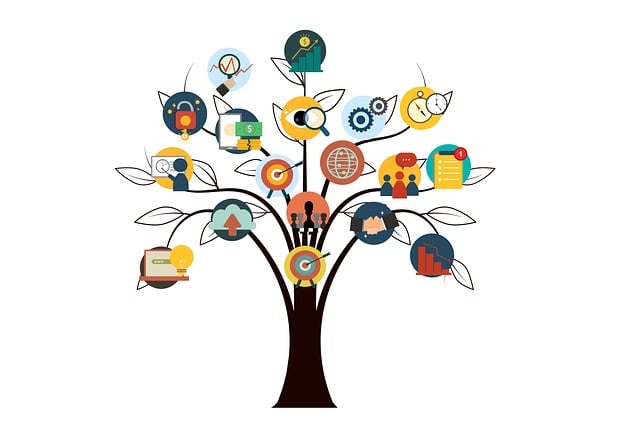Defining entities (departments, teams, products) and their relationships using Schema for Entities enhances brand understanding. Labeling these with Organization JSON-LD format improves search engine comprehension, enriching About Us Schema and knowledge panel displays. Structured data ensures consistency across platforms, boosts user experience, and increases brand visibility. Visual knowledge panels simplify complex structures, facilitating better internal & external decision-making.
In today’s data-driven landscape, organized schema for entities is crucial for brands aiming to optimize their online presence. This article explores how structured data, through defining entity relationships, structuring knowledge panels, and efficient information organization, enhances brand understanding. We delve into implementing schema, creating visual displays of entity connections, and optimizing user experiences. By harnessing the power of schema for entities, organizations can revolutionize their digital strategy, ensuring a competitive edge in the bustling online market.
- Defining Entities and Relationships for Accurate Branding
- Structuring Data: A Foundation for Knowledge Panels
- Implementing Schema: Organizing Information Efficiently
- Enhancing Brand Understanding with Structured Data
- Creating a Visual Display: Presenting Entity Connections
- Optimizing Knowledge Panel Functionality and User Experience
Defining Entities and Relationships for Accurate Branding

Defining entities and relationships within your organization is a pivotal step in crafting a robust schema for enhanced brand understanding. Entities represent the core components that make up your business, such as departments, teams, products, or services. By clearly identifying these entities, you establish the fundamental building blocks of your organizational structure. Each entity should be meticulously labeled and described to ensure precision and consistency throughout the schema.
Relationships between entities are equally important as they illustrate how different parts of your organization interconnect and influence each other. These relationships can be hierarchical (e.g., a subsidiary under a parent company), functional (like a marketing team within the sales department), or collaborative (indicating partnerships). Utilizing schema markup, specifically the Organization JSON-LD format, you can codify these entities and relationships, making it easier for search engines to comprehend your organization’s intricate web of connections. This structured data enriches your About Us Schema, enhances knowledge panel displays, and ultimately contributes to a more comprehensive brand representation online.
Structuring Data: A Foundation for Knowledge Panels

Structuring data is a fundamental step in creating an efficient knowledge panel display and enhancing brand understanding. By implementing schema for entities within your organization’s data, you establish a structured framework that enables machines to interpret and organize information logically. This process involves defining key elements such as people, places, and things relevant to your brand, and assigning them unique identifiers. For instance, a contact info schema can be designed to include details like the company name, address, phone number, and email, ensuring consistency across various digital platforms.
This structured brand data is then presented in a standardized format, often using Organization JSON-LD, which facilitates seamless integration with search engines and other applications. By organizing your data effectively, you empower knowledge panels to display comprehensive and accurate information about your organization, enhancing user experience and boosting brand visibility. This structured approach ensures that the vast pool of knowledge about your entity is accessible, understandable, and readily usable in various contexts.
Implementing Schema: Organizing Information Efficiently

Implementing schema is a powerful strategy to organize information efficiently within your organization, leading to enhanced brand understanding and improved knowledge panel displays. By utilizing structured data, such as Schema for Entities, you can ensure that critical details about your business are presented clearly and coherently. This organized approach facilitates seamless access to essential data points, enabling users to quickly grasp key aspects of your company.
For instance, implementing Logo Markup enhances the visual representation of your brand on various platforms. Contact Info Schema further streamlines the display of crucial contact details, making it convenient for customers to connect with your organization. These structured elements not only enrich the user experience but also contribute to a more comprehensive and accessible structured brand data repository.
Enhancing Brand Understanding with Structured Data

Implementing schema for entities within your organization’s digital infrastructure is a powerful strategy to enhance brand understanding and streamline knowledge presentation. Structured data provides a clear framework, allowing various platforms to interpret and display information coherently. By utilizing Schema for Entities, you can ensure that essential details about your business, such as location, contact info, operating hours, and services offered, are presented in a standardized manner. This consistency improves user experience, especially on search engines, where structured data enables rich snippets, making your organization’s listing more visible and informative.
For instance, consider the benefits of implementing Logo Markup within your schema. It adds a visual element to search results, instantly recognizable as your brand. Similarly, About Us Schema provides a structured narrative of your company’s history, mission, and values, offering potential customers a comprehensive insight into who you are. Even basic information like Contact Info Schema can significantly boost accessibility, ensuring your business is easily locatable and contactable through digital channels.
Creating a Visual Display: Presenting Entity Connections

Creating a visual display that effectively presents the connections between entities is a powerful way to enhance brand understanding through structured data. By leveraging schema for entities within your Organization JSON-LD or About Us Schema, you can create a rich, interactive knowledge panel that showcases critical relationships and hierarchical structures within your organization. This visual representation goes beyond simple textual descriptions, allowing stakeholders and visitors alike to grasp the intricate tapestry of your brand’s soul – its departments, roles, and interdependencies – in a concise and digestible manner.
The structured brand data presented visually can include hierarchical connections between teams and individuals, highlighting key projects or initiatives where entities collaborate, and demonstrating how each entity contributes to the whole. This level of detail enables better decision-making by providing clear insights into resource allocation, skill sets, and areas requiring additional support. By presenting this information in a structured format, you ensure that your organization’s narrative is not just told but also understood, fostering a more inclusive and informed community both internally and externally.
Optimizing Knowledge Panel Functionality and User Experience

Optimizing Knowledge Panels for Enhanced User Experience
Implementing a schema for entities within your organization’s structured brand data is a powerful strategy to elevate user experience and knowledge panel functionality. By utilizing Schema for Entities, you can provide search engines with detailed information about your business, including key details, offerings, and even historical context. This structured data enables search engines to display rich snippets in the form of knowledge panels, offering users at-a-glance insights into your organization.
About Us Schema, a specific implementation, allows users to quickly discover essential facts about your company—its mission, history, team, and services. Organization JSON-LD, another valuable tool, facilitates the structured presentation of brand data, ensuring that search engines can easily interpret and display your organization’s information in a user-friendly manner. This optimization not only enhances visibility but also fosters better brand understanding among potential customers.
